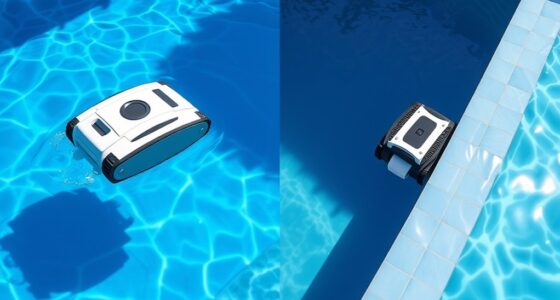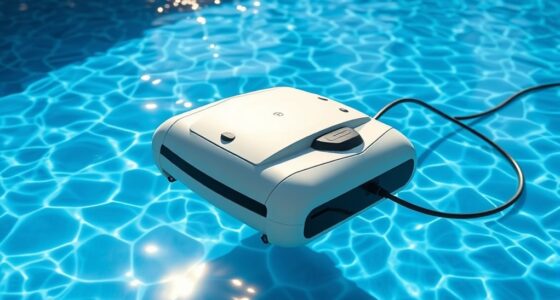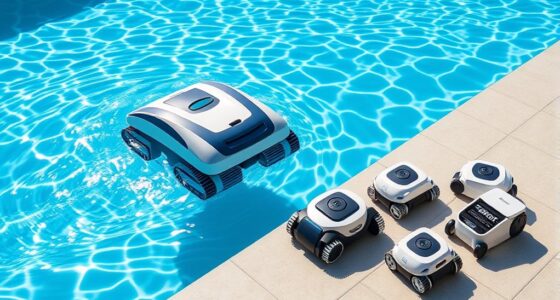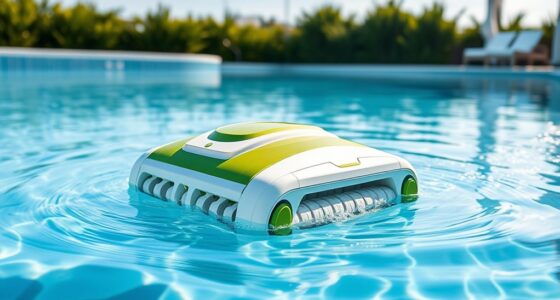If your automatic pool cleaner is struggling to pick up debris, frequently Clogs, or shows signs of corrosion or water damage, it’s time for a replacement. Mechanical issues like motor failures or parts that won’t move indicate wear and tear beyond repairs. Outdated features and rising repair costs also signal it’s time for an upgrade. To keep your pool sparkling, recognize these signs early and explore your options—more tips await if you continue.
Key Takeaways
- Notice a decline in cleaning effectiveness or frequent clogs despite maintenance.
- Encounter persistent mechanical issues, corrosion, or water damage signs.
- Repair costs become higher than replacing the cleaner or the model is outdated.
- Changes in pool size, usage, or debris types require a more suitable or advanced cleaner.
- Regular evaluation of performance, mechanical condition, and technology ensures timely replacement.
Decline in Cleaning Performance

Over time, your automatic pool cleaner may start to miss spots or struggle to pick up debris as effectively as it once did. This decline in cleaning performance often signals that maintenance tips haven’t kept it in prime condition. Regularly inspecting and cleaning the brushes, filters, and intake ports can help maintain efficiency. If you notice persistent issues despite routine maintenance, it might be time to consider replacement options. Sometimes, parts wear out or become clogged beyond simple fixes, making a new cleaner a more cost-effective solution. Additionally, wear and tear can significantly reduce a cleaner’s effectiveness over time. Performing routine maintenance can help identify early signs of decline and prevent premature replacements. Regularly replacing worn parts or filters can prevent further damage to the device and prolong its lifespan. It’s also important to monitor performance decline as a clear indicator that replacement might be necessary. Remember, a well-maintained cleaner performs better, but once it consistently underdelivers, replacing it ensures your pool stays clean without constant troubleshooting. Prioritize regular maintenance to extend its lifespan, but don’t hesitate to explore replacement options when needed. Proper maintenance techniques can significantly prolong your cleaner’s lifespan and effectiveness.
Persistent Mechanical Issues

Persistent mechanical issues can considerably hinder your automatic pool cleaner’s performance, even after routine maintenance. If you notice frequent jams, motor failures, or parts that won’t move properly, it’s a sign that repairs might not be enough. You’ll likely need to perform manual cleaning to clear debris buildup that’s causing strain on the device. Additionally, if the chemical balance in your pool isn’t maintained correctly, it can corrode parts or cause algae growth that impacts the cleaner’s mechanics. Continuous issues suggest the cleaner is nearing the end of its lifespan. Ignoring these problems can lead to further damage or costlier repairs. When mechanical issues persist despite troubleshooting, it’s often more practical to replace the unit than to keep investing in repairs. Proper maintenance practices and timely upgrades can extend the lifespan of many devices, including pool cleaners. Regular inspection of the cleaner’s components can help detect early signs of wear before major failures occur, saving time and money. Recognizing early signs of wear can also help prevent unexpected failures. Additionally, understanding the impact of environmental factors such as debris buildup and chemical corrosion can aid in better maintenance and decision-making regarding replacement.
Excessive Repair Costs

When the cost of repairing your automatic pool cleaner surpasses its value or the expense of a new unit, it’s a clear sign that replacement may be the smarter choice. Conduct a cost benefit analysis to determine whether ongoing repairs are worth the investment, especially if maintenance frequency has increased. Frequent repairs can quickly add up, making it more economical to buy a new cleaner rather than keep patching the old one. If you find yourself pouring money into repairs that don’t restore reliable performance, it’s time to contemplate replacement. A new model might offer better efficiency and fewer issues, saving you money in the long run. Don’t ignore mounting repair costs—sometimes, the most cost-effective move is a fresh start.
Outdated Model Features

As you consider replacing your automatic pool cleaner, it’s important to evaluate whether your current model keeps up with modern features and advancements. Outdated models often lack smart technology that allows for better navigation, scheduling, and remote control. They may also be less energy-efficient, leading to higher utility bills and increased wear. To help you decide, consider these points:
- No smart technology integration for automation or app control.
- Inefficient energy use compared to newer, eco-friendly models.
- Limited navigation capabilities, causing uneven cleaning.
- Lack of programmable features that save time and effort.
- Compatibility with modern smart home systems can also be a factor in determining whether to upgrade or replace your current model. Additionally, older models may not support advanced filtration systems, which can improve water quality and reduce maintenance needs. Incorporating technological advancements in pool cleaning devices ensures your cleaner performs efficiently and effectively. Staying informed about industry innovations helps you make better choices for long-term savings. Upgrading ensures you benefit from smarter, more efficient cleaning while reducing long-term costs. If your current model falls short in these areas, it’s likely time to replace it.
Frequent Clogs or Blockages
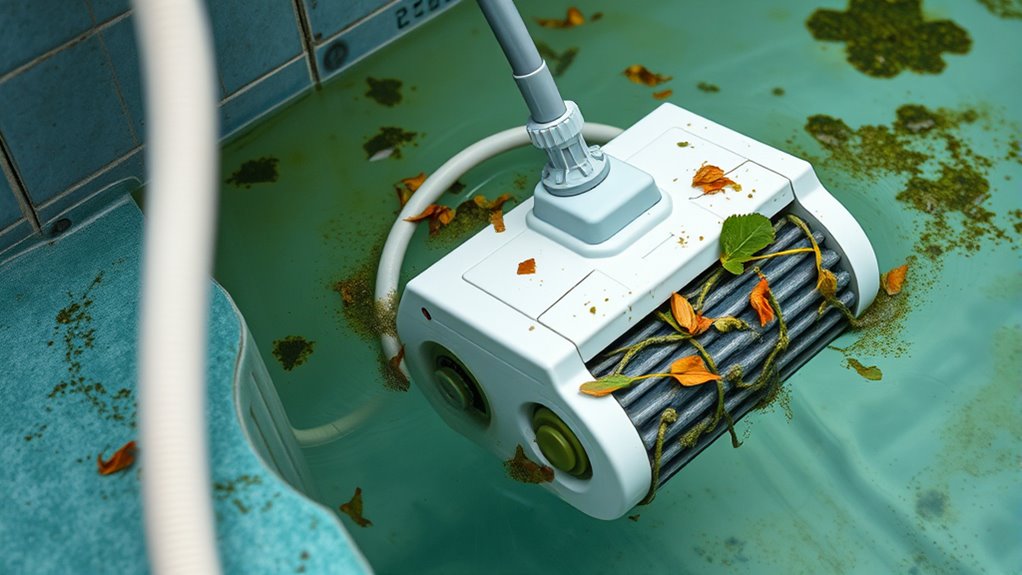
If your cleaner keeps getting clogged with debris, it can lead to frequent blockages and reduced performance. You might notice more debris buildup and cleaning failures over time. These issues often signal it’s time to contemplate replacing your device for more reliable operation. Regular maintenance and inspecting the suction efficiency of your cleaner can help prevent premature replacement.
Persistent Debris Accumulation
Persistent debris buildup can cause frequent clogs or blockages in your automatic pool cleaner, disrupting its performance and leaving your pool less than pristine. Over time, this buildup reduces energy efficiency and diminishes the pool’s aesthetic appeal. If you notice your cleaner struggling or needing constant maintenance, it may be a sign to replace it. Consider these points:
- Debris consistently jams the cleaner’s brushes or filters.
- Cleaning cycles take longer or are incomplete.
- The device uses more energy than usual, increasing costs.
- Visible wear or damage affects cleaning quality.
Addressing these issues early can save you time and money, but persistent debris accumulation often signals your cleaner’s time for an upgrade to restore peak performance and efficiency.
Increasing Cleaning Failures
When debris begins causing frequent clogs or blockages, your automatic pool cleaner’s performance suffers considerably. These issues often signal that your cleaner is struggling with model compatibility, especially if components aren’t designed for your pool’s debris load. Over time, repeated clogging can lead to motor strain and decreased efficiency. If your cleaner’s warranty has expired, repairs become costly and less reliable, making replacement a smarter choice. Regular blockages indicate it’s time to evaluate whether your current model still meets your pool’s needs. Upgrading ensures better debris management with improved filtration capabilities and reduces maintenance hassles. Recognizing these increasing cleaning failures early can save you money and time, preventing larger problems down the line. When frequent clogs persist, replacing your cleaner is often the most practical solution. Additionally, understanding the specific types of debris your pool accumulates can help in selecting a model with appropriate filtration capabilities.
Signs of Water Damage or Corrosion
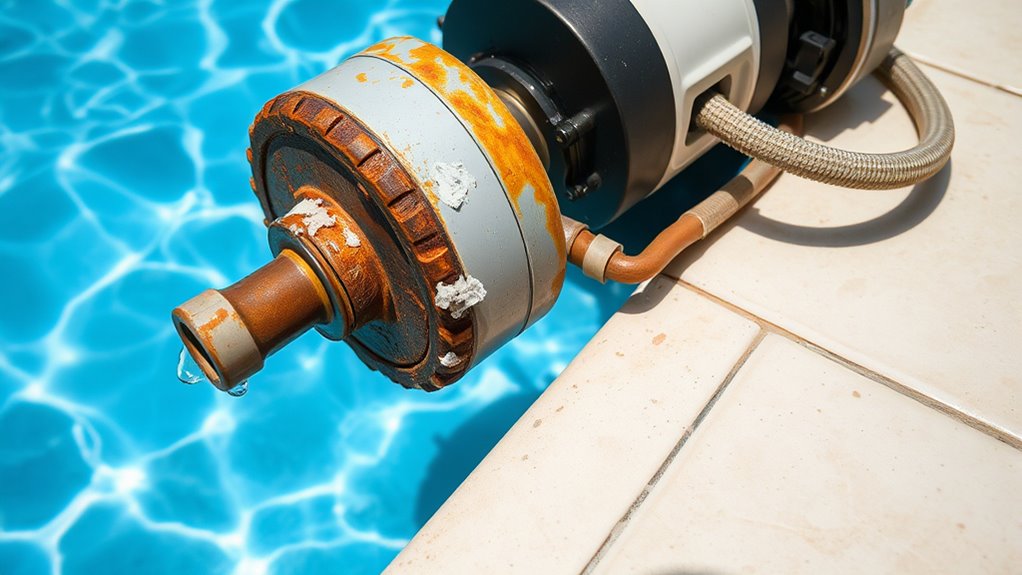
Water damage or corrosion often show up as visible signs on your pool cleaner, indicating it may be time for a replacement. Look for rust formation on metal parts, which weakens the structure. Electrical corrosion can cause poor motor performance or malfunctions, making the cleaner less effective. You might also notice corrosion around electrical connections or wires, leading to short circuits. Additionally, corrosion may cause parts to become loose or sticky, affecting movements. Keep an eye out for peeling paint or discoloration, which signals ongoing water exposure. Risk factors, such as prolonged water contact and humidity, can accelerate corrosion and damage. If these signs appear, it’s a good idea to think about replacing your cleaner to avoid further damage and ensure ideal pool maintenance. Staying proactive saves you time and money in the long run. Incorporating automation technologies can also help monitor and maintain your pool equipment more effectively, especially in damp environments that promote corrosion. Understanding how AI discoveries are improving maintenance strategies can further optimize your pool care routine, particularly through predictive analytics.
Changes in Pool Usage or Size
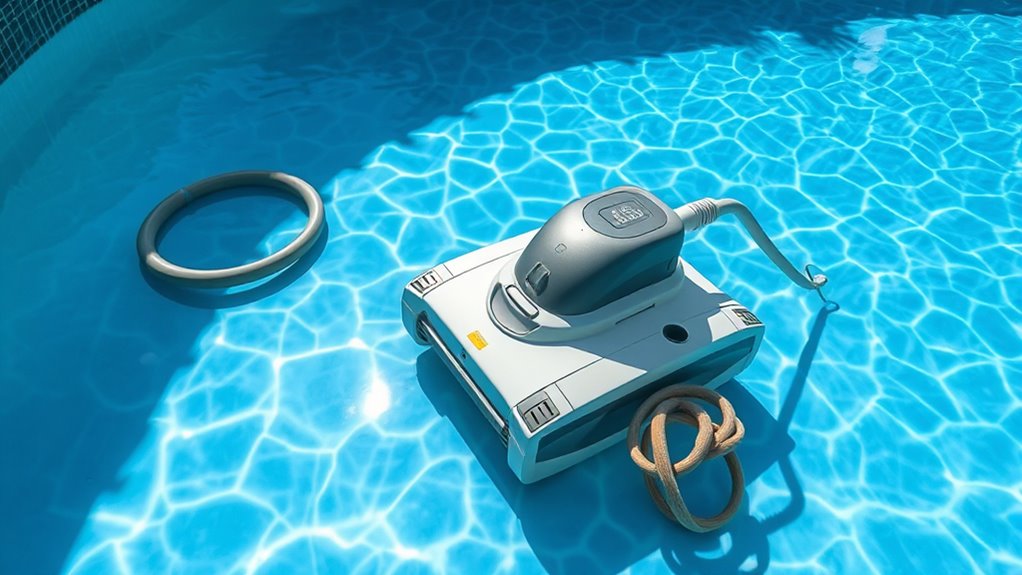
If your pool’s usage or size has changed substantially, it may be time to contemplate replacing your automatic pool cleaner. Pool size adjustments, such as enlarging or reducing the pool, can affect how well your current cleaner performs. A larger pool may require a more powerful or larger-capacity cleaner, while a smaller pool might need a model suited for tight spaces. Seasonal maintenance routines also impact cleaner effectiveness; if your pool’s usage increases during peak seasons, your existing cleaner might struggle to keep up. Upgrading ensures ideal cleaning without overworking your equipment. Regularly assess how your pool’s size and usage patterns evolve, so you can select a cleaner that fits your current needs, keeping your pool pristine all season long. Additionally, considering the type of ice cream recipes you prefer can be a fun way to cool off after pool maintenance. Proper maintenance routines can also extend the lifespan of your current cleaner, but if issues persist, replacement may be the best option.
Frequently Asked Questions
How Long Should an Automatic Pool Cleaner Typically Last?
Your automatic pool cleaner typically lasts between 3 to 5 years, depending on usage and maintenance. The pool cleaner lifespan varies based on how well you care for it and the frequency of use. Keep an eye out for signs like decreased cleaning performance or frequent breakdowns. When these occur, it’s time for a replacement. Following a regular replacement timeline helps guarantee your pool stays clean and the cleaner functions efficiently.
Are There Eco-Friendly Options for Replacing My Pool Cleaner?
Think of eco-friendly pool cleaners as the green arteries of your backyard. You can find sustainable options made from eco-conscious materials that reduce environmental impact. These cleaners often use energy-efficient motors and biodegradable parts, making them a smart choice for eco-conscious folks like you. By choosing sustainable options, you help protect our planet while keeping your pool sparkling clean. It’s a win-win, blending eco-awareness with effective pool maintenance.
Can Regular Maintenance Extend My Current Cleaner’S Lifespan?
Regular maintenance can definitely extend your pool cleaner’s lifespan. You should regularly clean the pool filter and guarantee the chemical balance stays ideal to prevent strain on the cleaner. Keep debris off the pool floor and check for wear and tear on brushes and wheels. Proper upkeep minimizes motor strain and prolongs functionality, saving you money and avoiding premature replacement. Consistent care keeps your cleaner running smoothly for years.
What Are the Signs of a Failing Motor in My Cleaner?
Think of your pool cleaner’s motor as its heartbeat. If you notice irregular operation, strange noises, or the cleaner struggles to move, it’s a sign of motor failure. You might also see reduced cleaning efficiency or it stops working altogether. These signs indicate your motor’s gears are wearing out, and it’s time to contemplate replacing your cleaner before it leaves your pool uncleaned. Don’t ignore these warning signs—they’re your cue to act.
Is It Better to Repair or Replace an Outdated Pool Cleaner?
Deciding whether to repair or replace your outdated pool cleaner depends on your situation. You should consider the cost comparison between fixing your current unit and buying a new one. Technological advancements have made newer models more efficient and easier to maintain. If repairs cost more than a replacement or your cleaner lacks the latest features, it’s better to invest in a new one. Upgrading guarantees longer-lasting, more effective pool cleaning.
Conclusion
Think of your pool cleaner like a trusted friend—when they start missing spots or constantly need fixing, it’s time for a new one. I once ignored small issues, only to spend more on repairs than a new cleaner would’ve cost. Don’t wait until your device becomes a sinking ship; replace it early to keep your pool sparkling and hassle-free. A good cleaner, like a good friend, keeps things running smoothly when you need it most.


